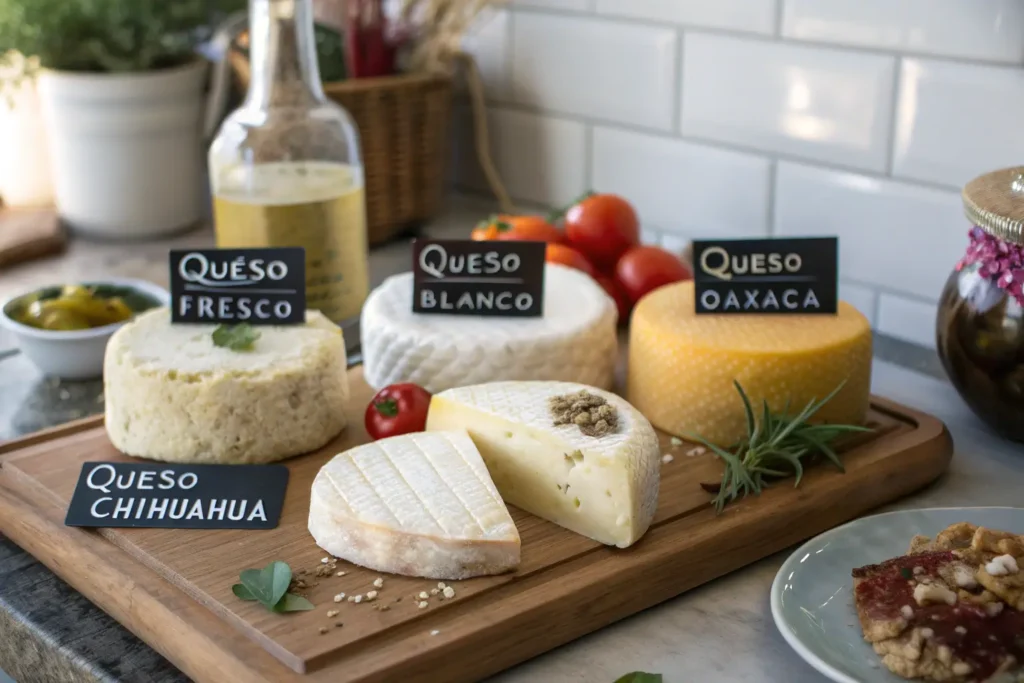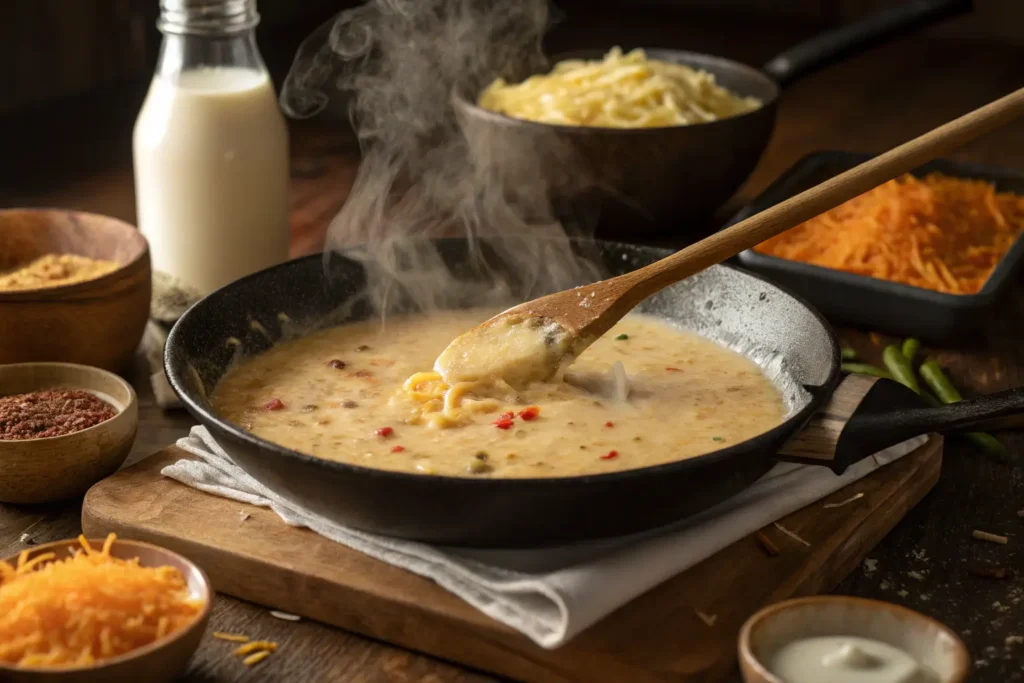Introduction
Let’s face it—when you think of comfort food, melted cheese probably tops the list. Whether it’s a gooey queso dip or a bubbling nacho topping, queso cheese has become a crowd favorite in kitchens and restaurants alike. But what makes queso so special? Is it the flavor, the meltability, or a little of both? In this article, we’ll dive into everything you need to know about queso cheese, starting with its roots and what makes it such a staple in so many dishes. Trust me, you’ll want to read this before your next taco night!
What is Queso Cheese?
Origins and History of Queso
Queso cheese, a cornerstone of Mexican cuisine, is known for its rich, creamy texture and versatility. Whether served as a dip, drizzled over nachos, or incorporated into recipes, queso has earned its place on tables worldwide.
For those who enjoy combining queso with classic comfort foods, you might find inspiration in dishes like Beef Queso Mac and Cheese, where the creamy queso takes center stage alongside hearty pasta.
Common Types of Queso Cheese

When it comes to queso, not all varieties are created equal. Here are a few popular types:
- Queso Fresco: A fresh, crumbly cheese often used as a topping for tacos and enchiladas.
- Queso Blanco: A white cheese with a slightly firmer texture, perfect for frying or melting.
- Queso Oaxaca: Known as Mexico’s version of mozzarella, this stringy cheese is great for melting in quesadillas.
- Queso Chihuahua: A semi-soft cheese that melts beautifully, often used in casseroles and dips.
Each type of queso has its own unique flavor and texture, making it a versatile choice for different recipes.
If you’re curious about how much cheese is too much, explore our insights in What Happens if You Put Too Much Cheese in Mac and Cheese?.
Popular Culinary Uses of Queso Cheese
Queso cheese is a culinary multitasker. You’ll find it in everything from appetizers to hearty main courses. Here are a few classic uses:
- Queso Dip: The ultimate party pleaser, often spiced up with jalapeños, tomatoes, and chili powder.
- Tacos and Burritos: Crumbled queso fresco adds a fresh, tangy finish to your favorite fillings.
- Quesadillas: Gooey queso oaxaca takes these grilled tortillas to the next level.
- Enchiladas: Melted queso chihuahua provides a creamy, flavorful topping.
Whether it’s shredded, melted, or crumbled, queso has a way of making any dish more delicious. Seriously, is there anything it can’t do?
Traditional and Modern Takes on Queso
For those craving a nostalgic take, consider trying a recipe like Old-Fashioned Baked Macaroni and Cheese, where a touch of queso can add a modern twist to a beloved classic.
The Science of Melting Cheese
Factors Influencing Cheese Meltability
Have you ever wondered why some cheeses melt into a smooth sauce while others stay lumpy or oily? It all comes down to science. The ability of cheese to melt depends on its moisture, fat, and protein content. Cheeses with higher moisture and fat levels tend to melt more easily, while those with a firmer structure, like aged cheddar or parmesan, are less cooperative.
Role of Moisture, Fat, and Proteins in Cheese Melting
Let’s break it down:
- Moisture: The higher the water content, the softer and more meltable the cheese.
- Fat: Adds creaminess and helps the cheese become smooth when melted.
- Proteins: The structure of the proteins affects whether the cheese stretches or simply liquefies.
Queso cheese typically falls in the middle of the spectrum, with just enough moisture and fat to create that perfect melt when handled properly.
Comparison of Queso Cheese with Other Melting Cheeses
How does queso stack up against classics like mozzarella or cheddar? While mozzarella is known for its stringy stretch and cheddar for its bold flavor, queso shines in its ability to blend into creamy sauces and dips. It’s less oily than cheddar and more versatile than mozzarella, making it a favorite for recipes that need a smooth, creamy texture without overpowering the dish.
Can Queso Cheese Be Melted?
Characteristics of Queso Fresco
Here’s the deal: not all queso cheese is created with melting in mind. Take queso fresco, for example. It’s crumbly, mild, and perfect for sprinkling over tacos and salads. But when it comes to melting, queso fresco doesn’t play nice. Its lower fat content and firmer structure mean it won’t turn into that smooth, gooey goodness you might expect. So, if you’re looking for meltability, queso fresco might not be your top pick.
Texture and Consistency Changes During Melting
When queso cheese is heated, its texture undergoes some pretty cool transformations. Soft cheeses like queso blanco or queso oaxaca melt smoothly into a creamy consistency. On the flip side, firmer cheeses like queso fresco tend to stay lumpy or separate into clumps if overheated. To get the perfect melt, it’s all about finding the right balance of heat and technique.
Cooking Techniques to Improve Queso Meltability
Wondering how to make queso cheese melt like a pro? Here are a few tricks:
- Shred or Crumble First: Smaller pieces melt more evenly, so take the time to prep your cheese properly.
- Use Low, Gentle Heat: High heat can cause the cheese to break apart or become grainy. Patience is key!
- Add a Liquid: Mixing in a bit of milk, cream, or even broth can help create a smoother texture.
- Stir Continuously: This prevents the cheese from sticking or burning and helps it melt uniformly.
With these tips, even a cheese that’s a little stubborn can become meltable magic.
Best Methods to Melt Queso Cheese

Stove-Top Melting Tips
The stovetop is one of the best ways to melt queso cheese because it gives you control over the heat. Here’s how to do it:
- Use a Nonstick Pan: This prevents sticking and makes cleanup easier.
- Start with Medium-Low Heat: Gradually warm the cheese to avoid separation.
- Incorporate a Liquid: Stir in some milk or cream for a creamy, smooth consistency.
Keep stirring, and don’t rush it. The result? Perfectly melted queso that’s ready for dipping or drizzling.
Using an Oven for Perfectly Melted Queso
If you’re making a dish like queso-stuffed enchiladas, the oven is your best friend. Here’s the game plan:
- Preheat the Oven: A consistent temperature helps the cheese melt evenly.
- Cover Your Dish: Use foil to trap moisture and prevent the cheese from drying out.
- Monitor Closely: Check the dish every few minutes to ensure the cheese melts without browning too much.
The oven method works wonders for baked dishes where you want that perfect, oozy cheese layer.
Microwave Techniques for Quick Melting
Short on time? The microwave can melt queso cheese quickly, but it requires a little finesse:
- Cut Cheese Into Small Pieces: Smaller pieces melt faster and more evenly.
- Use a Microwave-Safe Bowl: This is key for safety and even heating.
- Heat in Short Intervals: Nuke the cheese for 20-30 seconds at a time, stirring between intervals to prevent overheating.
While the microwave is convenient, it’s best for quick fixes rather than large batches or complex dishes.
Common Challenges When Melting Queso Cheese
Preventing Grainy or Clumpy Texture
One of the biggest complaints about melting queso cheese is the dreaded grainy texture. This usually happens when the cheese is overheated or not mixed with enough liquid. To fix this, use gentle heat and stir in a splash of milk or cream to keep things smooth.
Avoiding Burnt Cheese
Burnt cheese isn’t just a buzzkill—it can ruin the flavor of your dish. To avoid this, always melt queso on low heat and keep an eye on it. Stirring frequently helps distribute the heat evenly and prevents the cheese from sticking to the bottom of the pan.
Achieving Smooth and Creamy Consistency
If you’re aiming for a smooth, velvety cheese sauce, adding an emulsifier like cornstarch or a dash of cream can work wonders. These ingredients help bind the cheese and liquid together, creating a flawless texture that’s perfect for dipping or pouring.
Recipes Featuring Melted Queso Cheese
Classic Queso Dip
Let’s start with a crowd favorite: queso dip. This recipe is simple, quick, and the ultimate party snack. Melt queso chihuahua with a splash of milk, and add diced tomatoes, jalapeños, and a pinch of chili powder for a kick. Serve it with tortilla chips, and watch it disappear in minutes. Honestly, it’s impossible to stop dipping once you start.
Queso-Topped Nachos
If you’ve never had nachos topped with melted queso, you’re missing out. Layer tortilla chips on a baking sheet, drizzle generously with melted queso blanco, and sprinkle with your favorite toppings like beans, jalapeños, and diced onions. Pop it in the oven for a few minutes, and boom—you’ve got the ultimate snack for game day or movie night.
Queso-Stuffed Enchiladas
For a hearty meal, try queso-stuffed enchiladas. Fill corn tortillas with shredded chicken or beef, roll them up, and place them in a baking dish. Pour melted queso over the top and bake until bubbly. Garnish with fresh cilantro and serve with rice and beans for a meal that’s as satisfying as it is delicious.
Alternatives to Queso for Melting
Cheddar, Mozzarella, and Their Properties
If you’re out of queso cheese, don’t worry—there are plenty of alternatives that melt just as well. Cheddar is a great option for its bold flavor and smooth melt. Mozzarella, on the other hand, is perfect for dishes where you want that stretchy, gooey texture. Both are widely available and versatile for a variety of recipes.
Comparing Taste Profiles with Queso Cheese
Here’s the thing: queso has a mild, creamy flavor that blends seamlessly into dishes. Cheddar brings a sharpness, while mozzarella is more neutral. Depending on the recipe, you might prefer one over the other. For example, cheddar works well in chili or mac and cheese, while mozzarella is the go-to for pizzas and lasagnas.
When to Choose Queso Over Alternatives
So, when should you stick with queso? If you’re making Mexican or Tex-Mex dishes like tacos, enchiladas, or queso dip, queso cheese is your best bet. Its flavor complements spices like cumin and chili powder, and its texture is ideal for creamy sauces and dips. For other cuisines, you can experiment with alternatives, but for authentic Mexican flavor, queso is king.
FAQs About Queso Cheese
Is queso cheese good for melting?
Yes, queso cheese is excellent for melting—especially varieties like queso blanco and queso oaxaca. They melt into a smooth, creamy consistency that’s perfect for dips, sauces, and baked dishes. Just remember to use low heat and stir frequently for the best results.
Which cheese is the best melting cheese?
The best melting cheese depends on the dish. For Mexican recipes, queso oaxaca and queso chihuahua are top choices. Mozzarella and gouda are great for their stretchy texture, while American cheese melts into a creamy sauce without breaking apart.
Why won’t my queso cheese melt?
If your queso cheese isn’t melting, it’s likely due to its type or preparation. Queso fresco, for example, doesn’t melt well because of its low fat content and firm structure. To improve meltability, shred the cheese finely, add a liquid like milk, and melt it slowly over low heat.
What is the best Mexican cheese for melting?
The best Mexican cheese for melting is queso oaxaca, often referred to as Mexican mozzarella. It melts beautifully and is ideal for quesadillas, nachos, and enchiladas. Queso chihuahua is another excellent option, known for its creamy texture and mild flavor.
Conclusion
So, is queso cheese a good melting cheese? Absolutely! With its creamy texture and mild flavor, it’s a versatile choice for a wide range of dishes. Whether you’re making a classic queso dip, layering nachos, or experimenting with alternatives like cheddar and mozzarella, the key is to use the right technique. From stove-top methods to microwave tricks, there’s always a way to achieve that perfect, gooey consistency. Now, go grab some queso and start cooking—you’ve got this!


1 thought on “Is Queso Cheese a Good Melting Cheese? Everything You Need to Know”